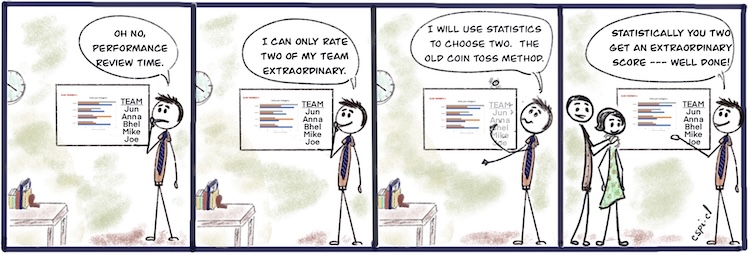Formal end of year performance feedback is linked to progress in compensation and position. This makes this formal performance feedback more difficult for managers who often struggle with what to say.
In companies with a large employee base, it is necessary to give direction to managers on how to measure an individual’s performance in a way that can lead to decisions regarding salary and career development and be fair across the company.
KPI’s and Performance Scores
KPI’s are frequently used as a basis for assessing performance. If you have met your KPI’s then you have done well and what was expected of you. If you failed to meet your KPI’s then you have not done well and have not achieved what was expected of you. Companies will translate the KPI results into five categories cleverly being five numbers one, two, three, four and five. Three is generally accepted as the score for someone who has achieved their KPI’s. One and two are reserved for those who have not and four and five kept for those who have performed over and above their KPI’s or have contributed in a way that is considered exceptional.
Managers are human and some are more stringent than others in giving performance feedback. Some are overgenerous, others are ‘Data is everything’ types. In between these two extremes there are many factors that influence managers one way or another. Some biases that creep in are:
Recency: if an employee has done something successfully just recently, there is a bias to place more value on the effort. Recency also works the opposite way so that a recent unsuccessful event can bias a manager against the perpetrator.
Seniority: there could be a bias to believe that seniority means better performance and newly hires not so much.
Likeability: managers favour employees who are likeable over those who are reserved or not particularly likeable.
Keeping exceptional scores under control
HR professionals, generally, develop performance feedback directives that favour the use of data to determine the category (one, two, three, four, five) into which an employee will fall. While achieving KPI’s naturally suggests a three, HR will also provide checklists as a guide to categorize an employee as exceptional. HR also has a responsibility to control costs and, as those categorized 4 or 5 will tend to receive greater pay, they will limit the number of employees in each department who can be rated at the higher levels. This has an effect of reigning in an overgenerous performance reviewer, but, can also create problems for effective leaders who have developed their team and have more than the allocated number of employees who should, rightfully, receive a 4 or 5 score.
It is this arbitrary limit to providing a four or a five category score that challenges managers.
It’s good to remember that while a company wants to reward both quality performers and exceptional performers, there is a limitation on the funding of salary increases.
A Way Forward
A helpful way of looking at the limited number of 4’s and 5’s that can be awarded to a body of employees, is to consider that they are not a limited number but rather a generous gift that the company wants to award to its MVPs. If you were a manager of seven people and you have the ability to choose up to two people to receive a category 4 or 5 designation you then look at the one or two people who are most deserving to be nominated as MVPs. This means, in effect, that some people who have performed exceptionally receive a 3 category, while one or two others who have performed more exceptionally have been recognized for that. It is easier to explain to employees that the company has given you the right to select two MVP’s, than fighting over a 4 or 5 score.
This is not a ‘trick’. It reflects the reality that given a limited number of potential 4 or 5 scores you, as a manager, have to determine who your MVP’s are.
When I was an executive in a major bank in Canada I had to deal with this scoring problem. At the time I was known as a ‘straight shooter’, however my staff complained that, while they agreed with the ratings I had shared with them, they pointed to other colleagues who had received higher ratings and were not worthy of them. That will happen. As a manager you need to be true to your values and act accordingly. A good manager will have the trust of their subordinates and if your rating is fair and fact based, they will be satisfied that they have been treated fairly.
At the end of the day, weekly one on one meetings with subordinates (or every two weeks if you have more than 5 direct reports) will ensure that there are no surprises in the formal annual performance feedback sessions.
Exceptions to the rule
There might be a time when the limit on the number of exceptional performers is unfair. As a leader you role is to then work to be given an exception. Find who has the authority to support your request. Be very pinpointed in explaining why an exception will be the fair thing to do. It has been my experience that a fair case will most times result in a fair decision. Bear in mind that the likelihood of being granted an exception will depend on the impact of the work that was done by the person you are endorsing. In a company that impact will be greater than exceeding a personal KPI. It will be justified by a wider impact affecting the future success of the company.

